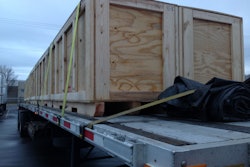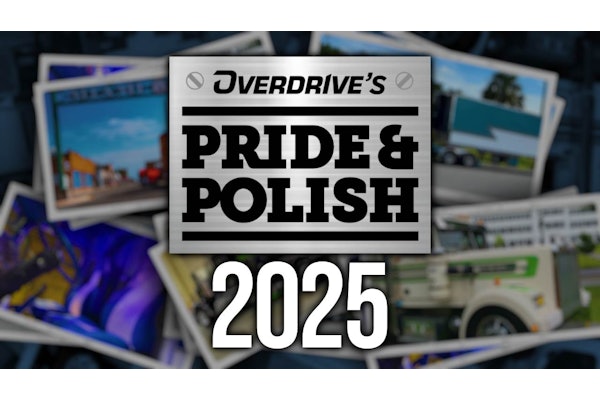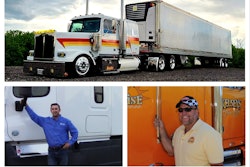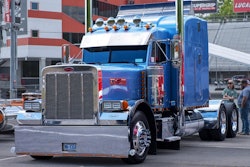The long-term goal of many independent owner-operators with their own authority is to expand beyond one truck. Often, the prime focus is to raise capital to invest in additional trucks, but some business veterans have discovered such an approach could be faulty in that it puts the equipment before the most important part of the equation in any expansion plan -- the driver.
In good economic times, expansion is a commonly explored option for naturally entrepreneurial owner-operators. Only one in four among Overdrive readers report never having considered it. Of the three in four who have considered the leap at some point in their career, research has shown, fewer than half of them remain a small fleet at any given time you ask the question.
Among the basic challenges of growth are increased liability insurance costs, new dispatch and freight management responsibilities, and increased opportunity for inspections and the associated fallout when things go wrong. That's not to mention the fundamental difficulty that can be managing other people for owner-operators used to holding responsibility most solely for their own actions.
Yet for an owner-operator well-equipped to manage himself, other drivers and staff, and company equipment, there's certainly opportunity for greater income long-term.

A traditional edge that small fleets have over large ones is that the culture is more family-like. Drivers are known by name, not a number, as it’s often put. The National Association of Small Trucking Companies' president routinely highlights what he's discovered about the small/large fleet differentiation. Early on in his career, with decades now spent supporting small trucking, he recognized that what set the full-truckload long-haul small fleet apart was the ability to attract and retain the million-mile driver, truly the safest driver on the road and the lifeblood of any great trucking company. That’s no doubt true in many small fleets, but the best extend the personal touch much further.
[Related: 'America's Best Drivers': NASTC touts 20 for '24 Driver of the Year team]
In Overdrive's most recent compensation survey, the largest share of respondents (62%) reported belief that the driver was indeed the most important part of the expansion equation.
Three principal areas of focus can help an owner-operator expand into a multi-truck business:
Compensation. The average income for full-time company drivers is between $50,000 and $75,000, depending on whose statistics you check. By finding a solid direct customer base and having good relationships with brokers, you can keep rates higher than average. Offering safety bonuses and other performance-based pay boosts can help attract drivers to your operation -- and keep them there.
Percentage compensation for employee drivers and leased owner-operators is common in new small fleets, and incentives like vacation and holiday pay also can help keep drivers around. Guaranteed minimums for compensation to backstop miles or percentage pay are becoming more common all around trucking, and small fleets are no exception.
Adding benefits such as health, vision, dental and chiropractic insurance will also help you compete with larger fleets who offer similar packages.
Equipment. The opportunity to operate top-shelf equipment encourages longevity with your company. Give drivers with tenured seniority the first choice when it comes time to buy new equipment.
Home time. It’s a common small-fleet practice to hire out of the area in which the company is headquartered. Many operate on an out-and-back model that gets drivers home for the weekend, if not even more frequently. A system like this also can help you get equipment back in one place for routine maintenance. Drivers’ needs should take precedence over equipment decisions.
[Related: 'The spot market is not where you need to live': On building business with authority toward growth]
Insurance considerations before expansion
When planning for growth, the impact to your trucking insurance is perhaps the easiest hurdle to prepare for. There are fundamentals that make it fairly simple to estimate the increase in premium costs when considering the impact of adding a truck, trailer and driver to the policy.
All things being equal (same truck and trailer type, year and value; same or similar driver age and motor vehicle record), you can expect the insurance premium to double when you increase from a one-truck operation to a two-truck operation. The biggest variable in estimating the premium increase, though, is going to be the driver.
More often than not, company drivers looking for a new job tend to have more infractions on their MVR than an established owner-operator might. Generally speaking, owners make a conscientious effort to be more diligent to protect their MVR. If you don’t, that MVR will have a bigger negative impact on insurance premium costs, as well as risking the existence of the business itself.
Use an MVR service to check any driver you consider as a hire well prior to purchasing the equipment. That will help avoid the potential hazard of making the biggest mistake of all -- hiring a driver who isn’t acceptable to the insurance company, or hiring a driver who causes insurance costs to increase to the point of being unaffordable.
Just as there are insurance risks with employee driver hires, though, the tactic of leasing owner-operators to your company in bids for expansion presents its own risks. On the surface, it's a very appealing option. Who could argue against not incurring additional debt for buying trucks? No truck maintenance headaches, no driver damaging the trucks you own... The list could go on. Yet insurance impacts are much the same for owners with a shaky MVR as they are with employee drivers.
Hiring qualified drivers
Overdrive research has found that small fleets have had success in advertising on their own equipment -- giving would-be drivers an idea of the equipment they can expect before they ever make a phone call.
Leveraging social media, such as Facebook and Twitter, to reach out to trucking associates in your personal network is another option.
Some things small fleets have tried with some success include:
- Putting company contact information on the back of a trailer. This can put the idea in another driver’s head to reach out and inquire about your company.
- Avoiding overly restrictive qualifications. If you’re having trouble finding a pool of drivers, and if you have a certain requirement, such as a hazmat endorsement or the ability to drive into Canada, consider rethinking that as a requirement. That may not be an option for your business, but if it is, it can expand the pool of candidates.
- Ramping up social media and other online efforts. If you haven’t already, create a Facebook page and a website for your company, and begin to advertise with both. Interacting on social media may require more of a weeding-out process than you want, but it can garner a lot of attention. Drivers can message you from your company’s page, which can begin a conversation.
Long-term management necessitates systems investment
The numerous small fleet owners profiled every year in the Fall as part of Overdrive's Small Fleet Champ recognition program routinely express pride in their ability to wear pretty much all hats you need to take care of the business. And it's certainly true that an owner-operator who adds truck while still behind the wheel himself is not only part-time mechanic, bookkeeper, driver, recruiter, HR manager and much more, building out a team to support the business's back office and more will ultimately be necessary.
 Overdrive in 2020 launched its Small Fleet Champ award program to recognize owners who have grown their operations beyond being a one- or two-truck outfit to between three and 30 trucks. You can find profiles of finalists and winners from the first five years of the program, and plenty of
Overdrive in 2020 launched its Small Fleet Champ award program to recognize owners who have grown their operations beyond being a one- or two-truck outfit to between three and 30 trucks. You can find profiles of finalists and winners from the first five years of the program, and plenty of
valuable profit-enhancing tactics and long-term business strategies, via this link to the wealth of surrounding reporting.
There are numerous TMS on the market to choose from, including systems geared toward specific freight niches in trucking. For more on small-fleet-focused TMS offerings, access this feature from Overdrive 2022 reporting.
Read next: How to get access to military freight








